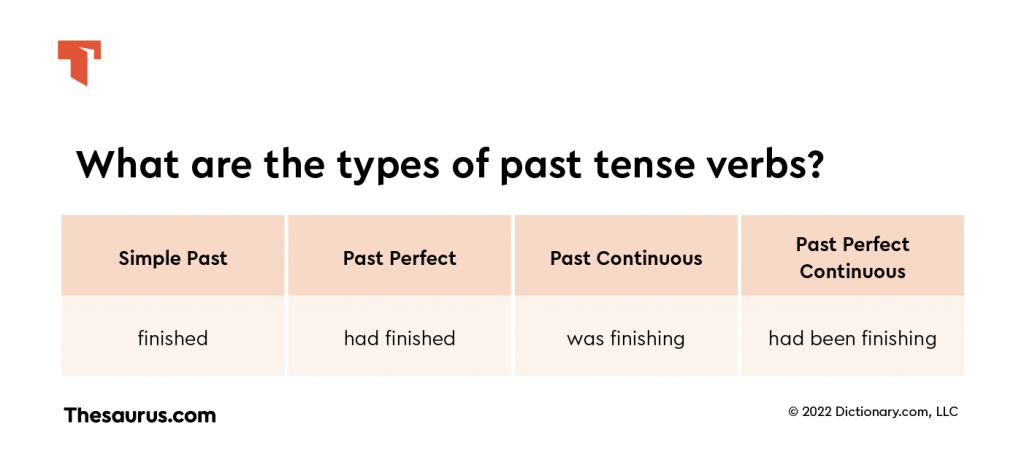Here is a story about something that happened yesterday. A man named Frank woke up late to discover that a mariachi band had been playing music outside his window all morning. He ran outside to see what was going on and learned that his neighbors were celebrating their daughter’s 15th birthday. He suddenly remembered that they had invited him to the party last week. Needless to say, he ran to the store to buy a gift and made it back in time before anyone realized what a forgetful person he had been.
If you are a grammar master, you may have noticed that this fun little story about Frank the Forgetful used many different verbs to refer to all of the actions and states that happened in the past. This story actually used all four of the different types of verb tenses that we use to talk about the past. It is time to stop living in the past, though, and return to the present in order to learn more about how we use verbs to refer to the past.

What is a past tense verb?
In general, we use past tense verbs to refer to states or actions that happened in the past. Typically, these verbs indicate that an action or state began in the past. Depending on the type of past tense verb we use, we can also indicate that the action or state ended in the past or it didn’t end and continues to happen right now. Some of the reasons we use past tense verbs include:
- To state an action/state began and ended in the past
- To say that a past action/state occurred before another past action/state
- To explain that a past action/state was the cause of another action/state
- To say that a past action/state was in progress when something else happened
- To say that a past action/state happened over a period of time before it was interrupted or it ended
- To state that an action/state began in the past and still hasn’t stopped happening even in the present
We present you with this helpful rundown of every verb tense in the present as well.
The four types of past tense verbs
In total, we use four different types of past tenses in our sentences. Here we provide names and examples of each type of past tense.
Simple past tense
- I sneezed.
- Greg walked his dog.
- They slept through the parade.
Past perfect tense
- She had finished two books by the time I finished one.
- My dad had already worked five jobs by the time he was 25.
- The robbers had stolen almost all of the jewels before they were caught.
Past continuous tense
- I was cooking dinner when Stacy walked in.
- Jamaal was working on his thesis paper the last time I saw him.
- My kids were smiling during our entire trip to Disneyland.
Past perfect continuous tense
- We had been living by the beach for years before we spotted our first whale.
- Amanda had been auditioning for the role for months before the director chose her.
- Horatio had been reading on the bench when the squirrel landed on him.
Simple past tense
Usually, the simple past tense is formed by adding -ed or -d to the end of the root of the verb. Some verbs also use a -t variant where they instead end in -t. The past tense of dream is dreamt, for example. However, there are many exceptions to this rule that you will simply need to learn. We use the simple past tense to refer to states and actions that began and completely finished in the past:
- I jogged three miles yesterday.
- Jessica helped Mike with his math homework.
- The ancient Egyptians built the pyramids.
- His lazy cat slept on the sofa all morning.
Past perfect tense
We form the past perfect tense by using the word had followed by the past participle of a verb (for regular verbs, ending in -ed, -d, or –t). We use the past perfect tense for several different reasons:
A past action/state happened before another one:
- I had finished my breakfast by the time my mom came to visit me.
Information reported by someone:
- She told me that Ben had broken the clock.
- The reporter said that the fire had started before noon.
Conditional statements:
- If I had brought an umbrella, I wouldn’t have gotten wet.
Past continuous tense
To form the past continuous tense, we use the past tense of the verb be followed by the present participle of the verb (ending in –ing). The verb be must be correctly conjugated so that it agrees with the subject of the sentence. As was the case with the past perfect tense, we use the past continuous tense for a few different reasons:
A past event was interrupted by something:
- We were having a fun barbeque when it started raining.
- The fox was sleeping peacefully until the wolf showed up.
Two past events were happening at the same time:
- Holly was hanging the decorations while Mahmud was wrapping the presents.
A past event was in progress:
- At 4:30, I was shopping at the mall.
- She couldn’t have broken the vase because she was swimming in the pool at that time.
Past perfect continuous tense
The past perfect continuous tense uses the phrase had been followed by the present participle of the verb (ending in –ing). We use the past perfect continuous tense to refer to actions/states that began in the past, continued for a period of time, and then completely ended in the past:
- My daughter had been building a sandcastle for 20 minutes when the mean bully destroyed it.
- Our band had been performing locally for years before the record agent discovered us.
Did you spot all the past tense verbs? Test out your skills with this quiz on past tense verbs.
All the verbs, none of the errors
Improve your writing with Thesaurus.com’s Grammar Coach™, which catches grammar and spelling errors and provides Thesaurus-powered synonym suggestions. Using machine learning, this tool can spot the difference between the different verb tenses, making sure you’re using them correctly—and much more!
Whether you’re writing in the past, present, or future, perfect grammar has never been easier.















